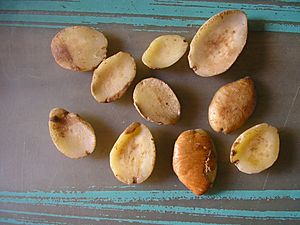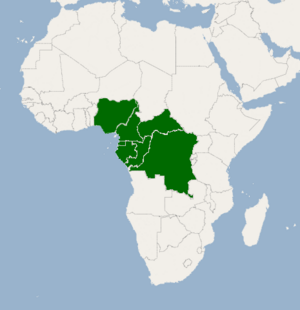African mango facts for kids
Quick facts for kids African mango |
|
|---|---|
 |
|
| Ogbono nuts | |
| Conservation status | |
| Scientific classification | |
| Genus: |
Irvingia
|
| Species: |
gabonensis
|
 |
|
| Natural occurrence of Irvingia gabonensis in Africa | |
| Synonyms | |
|
Irvingia barteri Hook.f. |
|
Irvingia gabonensis is a type of African tree often called wild mango, African mango, or bush mango. These trees grow tasty, mango-like fruits. People especially value them for their fat- and protein-rich nuts, which are very useful.
Contents
Where It Grows
The African bush mango tree naturally grows in the wet forest areas of Africa. You can find it from northern Angola all the way to south-western Uganda. This includes countries like Congo, DR Congo, Nigeria, and Ivory Coast. Since 2009, the government of Gabon has stopped people from cutting down these trees until 2034 to protect them.
What It Needs to Grow
This tree loves tropical climates that have both wet and dry seasons. It grows best in thick jungles, along rivers (called gallery forests), and in forests where some leaves fall off (semi-deciduous forests). It likes to grow at heights between 200 and 500 meters (about 650 to 1,640 feet). It needs about 1200 to 1500 millimeters (47 to 59 inches) of rain each year. The temperature should be between 20 and 38 degrees Celsius (68-100°F). The soil needs to be at least 150 centimeters (about 5 feet) deep, with good nutrients and proper drainage. It can grow in soil that is slightly acidic to slightly alkaline, with a pH from 4.5 to 7.5.
What It Looks Like
Irvingia gabonensis trees grow very straight and can reach up to 40 meters (about 130 feet) tall. Their trunks can be as wide as 1 meter (about 3 feet). The base of the tree often has wide supports, called buttresses, that can be up to 3 meters (10 feet) high.
The outside bark is smooth or a bit scaly, and it's usually grey to yellow-grey. The top part of the tree, called the crown, is always green, round, and thick with leaves. The leaves are shaped like an oval, and one side is often a bit rounder than the other. They are dark green and shiny on top.
The flowers are yellow to greenish-white and grow in small bunches. Each flower has both male and female parts. The fruit is almost perfectly round and turns green when it's ripe. Inside, it has bright orange flesh. The hard, woody pit (stone) holds one seed. When the seeds sprout, they grow above the ground.
How It Spreads in Nature
Insects like beetles, flies, Hymenoptera (like bees and wasps), and Lepidoptera (like butterflies and moths) help Irvingia gabonensis flowers make seeds. The tree usually flowers from March to June. It has two times when its fruits are ready: from April to July and again from September to October.
Animals like elephants and gorillas help spread the seeds. They eat the fruit and then drop the seeds in new places. But because there are fewer of these animals now, the trees don't spread as much on their own. This means the trees rely more on humans to plant them.
Growing the Trees
In the past, most African bush mango products came from wild trees in the forest. People didn't plant them much because they thought it took up to 15 years for a tree to start growing fruit. However, these trees were not often cut down for wood, so there were still many of them.
Today, we know that if you plant trees using a method called air-layering (where you grow roots on a branch while it's still on the tree), they can start producing flowers in just two to four years.
It's hard to grow these trees from seeds because many seeds don't sprout if they aren't handled correctly. People usually get the seeds by breaking open the fruits by hand.
Making New Trees
Growing African bush mango trees on farms is still quite new. Around 1990, new ways of growing plants, like vegetative propagation, made it possible to grow many new trees from parts of existing trees. Methods like grafting, budding, air-layering, and using cuttings work well if they are done on young wood.
How People Use It
People and many animals like monkeys, gorillas, and elephants often eat the fruits fresh. Since it grows mostly in parts of Africa, it's famously called African mango. People also turn the fruits into jelly, jam, juice, and sometimes even wine. The fruit pulp has also been used to make a black dye for coloring clothes.
To get to the edible part, you have to crack open the hard seed coat. The seeds, also known as dika nuts, can be eaten raw or roasted. Most often, they are ground into a butter-like paste or a block that looks like chocolate.
The seeds can be pressed to make an edible oil that is solid at room temperature, or a type of margarine used for cooking. This oil can also be used to make soap or cosmetics. What's left after pressing the oil (called press cake) can be used to feed cattle or as a thickening agent for soups. The seeds can also be ground or crushed and used to thicken and flavor soups and stews. They can also be made into a cake called "dika bread" to help them last longer.
In Gabonese cooking, the nuts are often used to flavor chicken and meat dishes, like "poulet à l'odika." The ground nuts give meals a smoky smell.
The wood from the tree is very hard. Because of this, it's used for strong building projects, like making ship decks or railway ties. Dead branches are used as firewood.
These trees are also helpful in agroforestry systems, where they are planted with other crops. They provide shade for plants like cocoa and coffee. They also help stop soil from washing away (erosion). In cities, people have started using them to shade streets, create windbreaks, or simply to make places look nicer.
Thousands of tons of African bush mango seeds are traded every year, mostly within Africa.
Nutrition Facts
The edible seeds are very nutritious. A 100-gram serving gives you 697 calories and these nutrients:
| Fat | 67 g |
| Carbohydrate | 15 g |
| Protein | 8.5 g |
| Water | 4 g |
| Calcium | 120 mg |
| Iron | 2.4 mg |
The fats in the seeds mostly include myristic acid (33–70%), lauric acid (20–59%), oleic acid (1–11%), palmitic acid (2%), and stearic acid (1%).
Unlike some other types of Irvingia fruit, the pulp of Irvingia gabonensis is juicy and sweet, so it's often eaten fresh. A 100-gram serving of fruit pulp provides 61 calories and includes:
| Water | 81 g |
| Carbohydrate | 15.7 g |
| Protein | 0.9 g |
| Fat | 0.2 g |
| Phosphorus | 40 mg |
| Calcium | 20 mg |
| Vitamin C | 7 mg |
| Iron | 2 mg |
The fruit pulp has flavors that make it taste spicy, earthy, fruity, and a bit like wine.
African Mango and Weight
Some food supplements made from Irvingia gabonensis are sold as "African mango" for people who want to manage their weight. While some studies suggest it might help a little with weight loss, more research is needed to be sure. It seems safe to use, with common side effects being headaches, gas, and trouble sleeping. However, because there isn't a lot of information yet, it's not currently recommended as a main way to lose weight.
See also
 In Spanish: Mango africano para niños
In Spanish: Mango africano para niños



